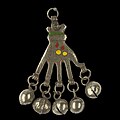Siwa oasis
| ⵙⵉⵡⴰ واحة سيوة Siwa oasis |
||
|---|---|---|
|
|
||
| Coordinates | 29 ° 11 ′ N , 25 ° 33 ′ E | |
| Basic data | ||
| Country | Egypt | |
| Matruh | ||
| ISO 3166-2 | EG-MT | |
| height | -18 m | |
| surface | 94,263 km² | |
| Residents | 23,672 (January 1, 2010) | |
| density | 0.3 Ew. / km² | |
The Siwa oasis ( Egyptian : Sekhetam = "palm land"; Siwi ⵙⵉⵡⴰ, Arabic واحة سيوة, DMG Wāḥat Sīwa ) is Egypt's most westerly group of oases in the Libyan desert and extends between the Qattara Depression in the north and the Egyptian Sand Sea in the south. It stretches over a length of 80 km and a width of 2–20 km and, as a depression, is on average 18 m below sea level.
Siwa is home to around 23,000 people, the majority of whom are Berber people . The Berber language Siwi is spoken in Siwa . The oasis group is therefore the only Berber language island in Egypt.
In addition to the main town of Siwa, a few villages (Aghurmi, Abu Shuruf, Chamisa, Bilad ar-Rum and Bahi ad-Din) and military stations are scattered around the oasis. The large gardens and plantations in Siwa mainly consist of around 300,000 date palms and around 70,000 olive trees . Vegetables, grapes, figs, oranges, apricots and other agricultural products are also grown for local consumption.
history
The history of the oasis can be traced back to the 18th dynasty (1500 BC). The main temple, which was dedicated to the god Amun , and the sayings of his oracle were known far beyond the borders of the kingdom of the pharaohs. The most famous visitor to the oracle is undoubtedly Alexander the Great , who used the oracle's power and influence and was welcomed in Siwa as the "son of Zeus".
In ancient times, Siwa was known as Ammonion or Ammonium as an oracle site of the Bedouins (see Oracle of Siwa ). At the end of the 18th century , the location of the so-called Ammon Oasis, where Alexander the Great consulted the oracle, was hardly known in Europe. William George Browne visited the valley in 1792 and after him Friedrich Konrad Hornemann . Both provided hints for equating Ammon-Oasis and Siwa through their own perception.
Picture gallery
Amun Temple of Siwa Oasis
Climate table
| Siwa | ||||||||||||||||||||||||||||||||||||||||||||||||
|---|---|---|---|---|---|---|---|---|---|---|---|---|---|---|---|---|---|---|---|---|---|---|---|---|---|---|---|---|---|---|---|---|---|---|---|---|---|---|---|---|---|---|---|---|---|---|---|---|
| Climate diagram | ||||||||||||||||||||||||||||||||||||||||||||||||
| ||||||||||||||||||||||||||||||||||||||||||||||||
|
Average monthly temperatures and rainfall for Siwa
Source: wetterkontor.de
|
|||||||||||||||||||||||||||||||||||||||||||||||||||||||||||||||||||||||||||||||||||||||||||||||||||||||||||||||||||||||||||||||||||||||
Remarks
- ↑ Ferdinand Tönnies suspected that Apollon Carneios was the previously venerated deity ( De Jove Ammone questionum specimen , Tübingen 1877)
literature
- Dr. W. Geilinger: In the heart of Libya. The Siwa oasis. A journey in pictures . In: Atlantis. No. 2, 1931, pp. 6-11.
- Frank Bliss : Siwa. The oasis of the sun god. Life in an Egyptian oasis from the Middle Ages to the present day (= contributions to cultural studies. Vol. 18). PAS, Bonn 1998, ISBN 978-3-921876-21-3 .
- Joachim Willeitner : The Egyptian oases. Cities, temples and graves in the Libyan desert (= ancient world . Special issue; Zabern's illustrated books on archeology ). von Zabern, Mainz 2003, ISBN 3-8053-2915-6 .
- Mathias Döring: Well in the desert - water in the Libyan desert of Egypt using the example of Siwa. In: Wasser und Brunnen 12, 2020, 58–69.
Web links











